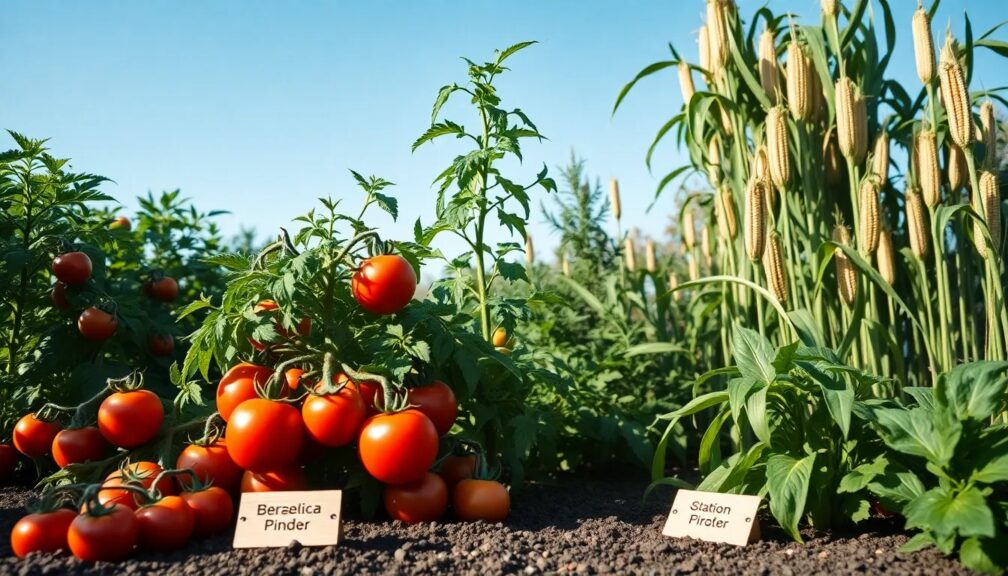What should you not plant next to tomatoes

Welcome to our guide on gardening companions: What You Should Not Plant Next to Tomatoes
Tomatoes are a beloved staple in many gardens, appreciated for their versatility and the rich flavor they bring to a variety of dishes. However, to ensure these vibrant fruits flourish, it's crucial to understand companion planting – the practice of growing certain plants in proximity for mutual benefit. While some plants can enhance the growth and flavor of tomatoes, others can be detrimental, leading to poor yields or increased susceptibility to disease and pests. In this article, we will explore the antagonistic plants that you should keep at a distance from your tomato plants to promote a healthy and bountiful garden. Whether you're a seasoned gardener or just starting out, knowing what not to plant next to tomatoes is key to a thriving vegetable patch.
What is the best companion plant for tomatoes?
Discover the secret ally of your tomato garden that could skyrocket your harvest and keep your plants thriving. Imagine walking into your garden, the scent of fresh tomatoes hanging in the air, perfectly plump and blemish-free fruits dangling from the vine. Now, what if a simple addition to your garden could enhance growth, deter pests, and improve flavor?
The answer lies in an age-old gardening technique called companion planting, and for tomatoes, this practice can be a game-changer. But not all companions are created equal. Some plants, when paired with tomatoes, form a symbiotic relationship that is nothing short of magical.
1. Basil - This culinary favorite does more than add flavor to your dishes. When planted next to tomatoes, basil may help to repel pests like thrips and mosquitoes, while potentially boosting the growth and flavor of your tomatoes.
2. Marigolds - These vibrant flowers aren't just a pretty sight. The strong scent of marigolds can ward off nematodes and even rabbits, keeping your tomato plants safe and sound.
3. Garlic - Known for its potent smell, garlic can be a pungent protector for your tomatoes, driving away invaders like spider mites and aphids.
The intrigue doesn't stop there. Some plants can attract beneficial insects that prey on common pests, or even improve soil health for a bountiful tomato yield. But choose your plant allies wisely, as the wrong neighbors can spell disaster for your beloved tomatoes.
Ready to transform your garden into an oasis of productivity and harmony? Keep reading to unveil the top companion for your tomato plants that can turn your garden into the envy of the neighborhood. Embrace the power of companion planting and watch as your tomatoes reach new heights of flavor and vitality. Don't miss out on the opportunity to unleash the full potential of your garden. The perfect companion is waiting to join your tomato plants, and the results will be nothing short of extraordinary.
What should not be mixed with tomatoes?
You might find yourself standing in the kitchen, the vibrant red of a tomato catching your eye. It's a staple in countless dishes, a beloved addition to salads and sandwiches, but pairing it with certain foods can lead to not just culinary disappointment, but also health implications.
First and foremost, brace yourself for a startling revelation – dairy products and tomatoes are not the dream team you thought they were. Combining cheese with that tomato sauce might be tempting, but it could result in a heavy feeling in your stomach, as the high acidity of tomatoes clashes with the rich proteins in dairy.
While we're on the topic of proteins, let's talk about seafood. This might be surprising, but the tiniest drop of tomato in seafood dishes can unleash a flavour profile that's less than ideal. Not only does it overshadow the delicate taste of fish and shellfish, but it also might cause reactions for those with specific sensitivities.
And here's the kicker – even certain vegetables should keep their distance from tomatoes. The likes of cucumbers and green peppers can become victims of the tomato's domineering nature, leading to digestive discomfort and a less-than-satisfying meal experience.
But wait, there's more! Did you know that the way you store tomatoes could be affecting your other produce? It might seem convenient to toss them into the fruit bowl or the fridge with everything else, but doing so could hasten the spoilage of surrounding foods.
The intrigue doesn't end there. Imagine the hidden nuances, the culinary secrets yet to be unearthed about the tomato. What if I told you there are herbs and spices that could elevate your tomato dishes to new heights? Or that certain preparation methods could lock in flavors you never thought possible?
Stay tuned, because the world of tomatoes is vast and full of mystery. The more you delve into it, the more you realize – the knowledge you hold is just the tip of the iceberg.
Why should you not plant cucumbers near tomatoes?
Imagine stepping into your garden, the fruits of your labor spread before you, lush tomato plants towering over plump, juicy cucumbers. It's a beautiful sight, but hidden beneath this picturesque scene lies a potential horticultural disaster! You may have heard whispers or even loud warnings from seasoned gardeners cautioning against the close kinship of cucumbers and tomatoes. The reason? A complex web of interactions that could jeopardize your dream harvest.
Firstly, consider the fierce competition for resources. These vigorous plants are both heavy feeders, battling underground for water and nutrients. This struggle can lead to stunted growth and a diminished yield. But that's just the tip of the iceberg.
Pathogens are another invisible threat. Tomatoes and cucumbers can fall prey to similar diseases, such as powdery mildew and fungal infections. When planted side by side, the risk of cross-contamination skyrockets, creating a perfect storm for a garden epidemic.
Moreover, the concept of allelopathy plays a crucial role. Some plants release chemicals that can be detrimental to others. While the evidence of tomatoes and cucumbers engaging in this biochemical warfare is anecdotal, it's a factor that could tip the scales in an already delicate balance.
And let's not forget about the pests. These plants attract some of the same insects that love to feast on their sap and fruit. Close quarters mean these critters can easily hop from one plant to the next, turning your garden into an all-you-can-eat buffet.
It's a gardening challenge that seems straightforward but is shrouded in layers of complexity. By unraveling these threads, you can unlock the secrets to a healthier, more bountiful garden. Discover the intricacies of plant companionship and the crucial dos and don'ts, ensuring your green thumb gets the recognition it deserves. Stay tuned for the deep dive into creating the perfect garden symphony, where every plant finds its harmonious place under the sun.
Should I put something around my tomato plants?
The question on every gardener's mind as they gaze upon their budding tomato plants: what can surround these delightful vegetables to maximize their yield? The answer isn't just a simple yes or no—there's a whole world of strategy and innovation that can catapult your garden into a veritable Eden of tomatoes.
Firstly, consider the stakes at play. Not just the physical stakes you might use to support your plants, but the high stakes of tomato cultivation. By placing the right materials around your plants, you can enhance growth, improve health, and increase production. It's not just about growing tomatoes; it's about growing the best tomatoes anyone has ever seen.
Imagine walking into your garden and seeing a vibrant array of lush, red fruits—fruits that are the envy of every neighbor and the star of every salad. This dream can be your reality with a little know-how.
So, what are these materials that promise to transform your garden? Here's a sneak peek:
1. Mulch—this simple addition can regulate soil temperature, retain moisture, and inhibit weeds.
2. Support structures—think beyond basic stakes to trellises and cages that can handle the weight of your abundant harvest.
3. Companion plants—certain flowers and herbs can deter pests and diseases, all while attracting beneficial pollinators.
But that's just scratching the surface. Each of these options comes with hidden depths and techniques that can shift the balance of your garden ecosystem in favor of your tomatoes. By delving into the art of what surrounds your tomato plants, you can unlock secrets that experienced gardeners have been honing for generations.
Stay tuned as we unveil the surprising impacts of each material and method, transforming your approach to tomato gardening forever. The time to elevate your garden game is now, and the key lies within the choices you make for your tomato plants. Don't let the potential of your garden be the best-kept secret.
What should you not plant next to tomatoes in pots
Unlock the secrets of a thriving garden by understanding the subtle, yet critical art of companion planting! Picture your tomato pots, overflowing with ripe, juicy fruits, a testament to your green thumb. But beware, for this vision of abundance can quickly become a horticultural nightmare if certain plants are allowed to encroach on your tomatoes' territory.
Here's a teaser of the unfriendly neighbors that could spell disaster for your tomato plants:
- Corn: A beacon for tomato pests, this tall plant could inadvertently invite a horde of unwanted visitors that may decimate your precious tomatoes.
- Brassicas: Broccoli, kale, and cabbage look innocent enough, but they release compounds that can stifle the growth of your tomato plants.
The list doesn't end there, and you might be surprised by some of the common culprits that could be lurking in your potting shed right now.
But wait, there's more to this story than just a list of don'ts. Harness the power of positive plant synergy by discovering the benevolent buddies that will not only coexist peacefully with your tomatoes but will actually help them flourish.
Find out which plants can enhance flavor, repel pests, and provide much-needed shade, creating a harmonious ecosystem right on your balcony or patio.
Don't miss out on the full reveal of plant allies and adversaries. Your tomato plants are counting on you to unlock the full potential of every pot. Stay tuned for the unexpected twists and turns in the world of companion planting – your ultimate guide to becoming the envy of the neighborhood with the most luscious tomato plants on the block!
Consejo final: For those interested in gardening, it's crucial to remember that tomatoes do not fare well when planted near cabbage, broccoli, brussels sprouts, kale, or cauliflower. These plants can hinder the growth of tomatoes due to their competing nature for nutrients and space. To ensure a bountiful tomato harvest, give your plants the right companions and avoid the aforementioned ones. May your garden flourish and your tomatoes thrive. Best of luck with your gardening endeavors!
 What veggies to plant next to each other
What veggies to plant next to each other Is it better to plant vegetables in rows or groups
Is it better to plant vegetables in rows or groups How do I prepare my yard for a garden
How do I prepare my yard for a garden What should I grow first in my garden
What should I grow first in my garden What do farmers use to turn over soil
What do farmers use to turn over soilIf you want to know more about similar articles like What should you not plant next to tomatoes you can visit category Gardening Tools.